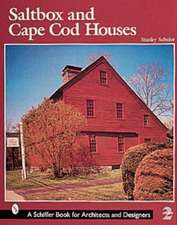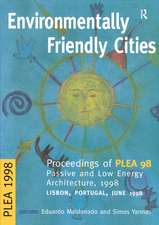Lessons from Vernacular Architecture
Editat de Willi Weber, Simos Yannasen Limba Engleză Hardback – 19 aug 2013
Preț: 1006.69 lei
Preț vechi: 1106.25 lei
-9% Nou
192.64€ • 205.99$ • 160.61£
Carte tipărită la comandă
Livrare economică 18 aprilie-02 mai
Specificații
ISBN-10: 1844076008
Pagini: 240
Ilustrații: 276 colour illustrations, 4 colour tables
Dimensiuni: 174 x 246 x 18 mm
Greutate: 0.78 kg
Ediția:New.
Editura: Taylor & Francis
Colecția Routledge
Locul publicării:Oxford, United Kingdom
Public țintă
Professional Practice & DevelopmentCuprins
Introduction (Willi Weber and Simos Yannas) Part One: Bioclimatic Facets of Vernacular Architecture 1.Four Elements of Santorini Architecture Lessons in Vernacular Sustainability (Thanos Stasinopoulos) 2. Shape, Culture and Environment: a Lesson in Urban Design at the Dakleh Oasis (Riccardo Balbo) 3. Windows as Environmental Modifiers in Lebanese Vernacular Architecture 4. The Historic Hammāms of Damascus and Fez: Lessons of Sustainability and Future Developments (Magda Sibley) 5. H.AM.M.A.M. Project and Climate Design of Islamic Bath Buildings (Jean Bouillot) 6. The Environmental Performance of Traditional Courtyard Housing in China ߝ Case Study: Zhang’s House, Zhouzhuang, Jiangsu Province (Benson Lau, Brian Ford, Hong-Ru Zhang) 7. Comfort in Outdoor Spaces in Turkish Architecture (Armagan Gulec, Mustafa Korumaz and Fatih Canan) Part Two: Vernacular Architecture as Model 8. Applying the Lessons of Indian Vernacular Architecture: The Bungalow as Example of Adaptive Climatic Response (Kimberly Kramer) 9. Lighting Features in Japanese Traditional Architecture (Jose Maria Cabeza) 10. Bioclimatic Lessons from Luis Barragan’s Architecture (Anibal Figuroa and Gloria Castorena) 11. Architecture Integrated to Nature: The Use of Timber by Severiano Porto in Brazilian Amazon (Leticia Neves) 12. Questioning the Lessons of Tradition: Comparison of Traditional Houses from Different Climatic Regions of Thailand with a Typical Comtemporary House Design (Kevin McCartney, Paruj Antarikananda and Elena Douvlou) 13. Wee Energy House; Environmentally Responsive Architecture for Rural Northern Ireland (Joy-Anne Fleming) 14. The Vernacular as a Model for Sustainable Design (Wayne Forster, Amanda Heal and Caroline Paradise)
Notă biografică
Willi Weber is an architect and Professor of Building Physics at the Institute of Environmental Sciences of the University of Geneva, Switzerland. As director of the University's Centre for the Study of Energy Problems (CUEPE) he was in charge of a research group involved in expert appraisals in the field of energy and environment in architecture. He was the chairman of the 23rd International PLEA (Passive and Low Energy Architecture) Conference that was held in Geneva in 2006.
Simos Yannas is the Director of the Environment & Energy Studies Programme at the Architectural Association School of Architecture in London, UK where he is responsible for the Masters programmes in Sustainable Environmental Design and the AA School’s PhD Programme. His previous book with Earthscan, Roof Cooling Techniques: a Design Handbook (2005) was shortlisted for the Royal Institute of British Architects' RIBA Bookshops International Book Award in Architecture. He is a founding member of the PLEA international network.
Descriere
The architectural community has had a strong and continuing interest in traditional and vernacular architecture. Lessons from Vernacular Architecture takes lessons directly from traditional and vernacular architecture and offers them to the reader as guidance and inspiration for new buildings. The appropriate technical and social solutions provided by vernacular and traditional architecture are analysed in detail. International case studies focus on environmental design aspects of traditional architecture in a broad range of climatic conditions and building types.























